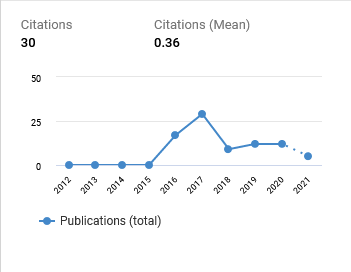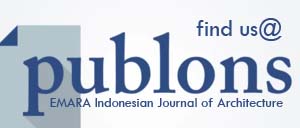The Effect of Physical Quality Improvement to Inhabitant’s Sense of Place
DOI:
https://doi.org/10.29080/eija.v5i1.656Keywords:
sense of place, physical quality improvement, Kampung Lawas MaspatiAbstract
Sense of place is closely related to the level of community participation and sustainability development. In this paper, the context of environment is tourism kampung. Tourism kampung has a dynamic activities and cultural values both tangible and intangible. The development of tourism kampung has a positive goal to improve inhabitant’s socio-economic welfare. But, there was a change in kampung’s function, activity and meaning from a closed settlement system with low social accessibility to a tourism kampung. This change can also affect the people’s sense of place. Research method used in this study is mixed method, which combines quantitative and qualitative research. Data collection techniques were obtained from questionnaires, field observations, and in depth interviews. The result shows that physical improvement has a positive effect in escalating the level of inhabitant’s sense of place. The finding will be important to the development of the sense of place’s theory and sustainable development.
Downloads
References
Adedokun, A. M., & Mnitp, A. C. (2013). The Dynamics Of Street Furniture In Urban Centres: The Lagos Example. International Journal of Advancements in Research & Technology, 2(3), 10.
Canter, D. V. (1977). The psychology of place. London: Architectural Press.
Hutama, I. A. W. (2016). Exploring the Sense of Place of an Urban Kampung Through the Daily Activities, Configuration of Space and Dweller’s Perception: Case Study of Kampung Code, Yogyakarta (Thesis, University of Twente). Retrieved from https://webapps.itc.utwente.nl/librarywww/papers_2016/msc/upm/hutama.pdf
Lawrence, R. J. (1987). Housing, dwellings and homes: Design theory, research and practice. Canada: John Wiley & Sons.
Lynch, K. (2003). The Image of the City. Massachussets: MIT Press.
Mitchell, W. J., Canter, D., & March, L. (1977). Reviews: Shape Grammars and Their Uses, Pictorial and Formal Aspects of Shape Grammars, the Automated Architect, Place and Placelessness, from Geometry to Topology, Surfaces: Environment and Planning B: Planning and Design, 4, 118–120. doi: 10.1068/b040115
Montgomery, J. (1998). Making a city: Urbanity, vitality and urban design. Journal of Urban Design, 3(1), 93–116. doi: 10.1080/13574809808724418
New Urban Agenda. (2016). The New Urban Agenda, 18. Retrieved from http://habitat3.org/the-new-urban-agenda/
Punter, J. (1991). Participation in the design of urban space. Landscape Design, 200, 24–27.
Ramadhani, A. N., Faqih, M., & Hayati, A. (2017). Behaviour setting and spatial usage analysis on sombo low cost flat’s corridor. Journal of Architecture&ENVIRONMENT, 16(1), 61-74–74. doi: 10.12962/j2355262x.v16i1.a3189
Ramadhani, A. N., Faqih, M., & Hayati, A. (2018). Inhabitant’s Sense of Place in the Context of Tourism Kampung. Journal of Architecture & Environment, 17(2), 151-168–168. doi: 10.12962/j2355262x.v17i2.a3894
Ujang, N. (2008). Place Attachment towards Shopping Districts in Kuala Lumpur City Centre, Malaysia (PhD Theses, Universiti Putra Malaysia). Retrieved from http://psasir.upm.edu.my/id/eprint/4927/
Yohanes. (1991). Inventarisasi kampung-kampung di Surabaya: Studi kasus kampung Maspati. Retrieved from https://dewey.petra.ac.id/catalog/digital/detail?id=14041

Downloads
Published
How to Cite
Issue
Section
Categories
License
- Authors retain copyright and grant the journal right of first publication with the work simultaneously licensed under a Creative Commons Attribution ShareAlike License that allows others to share the work with an acknowledgment of the work's authorship and initial publication in this journal.
- Authors are able to enter into separate, additional contractual arrangements for the non-exclusive distribution of the journal's published version of the work (e.g., post it to an institutional repository or publish it in a book), with an acknowledgment of its initial publication in this journal.
- Authors are permitted and encouraged to post their work online (e.g., in institutional repositories, pre-print sites, or on their website) prior to and during the submission process, as it can lead to productive exchanges, as well as earlier and greater dissemination of published work.
































